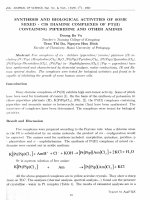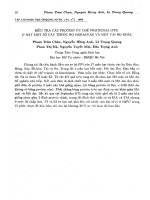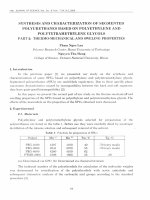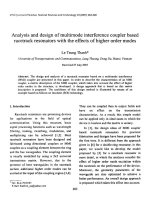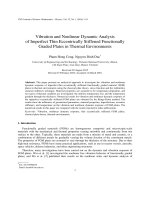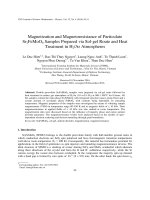DSpace at VNU: Reconstruction and electronic properties of interface between carbon nanotubes and ferromagnetic Co electrodes
Bạn đang xem bản rút gọn của tài liệu. Xem và tải ngay bản đầy đủ của tài liệu tại đây (564.06 KB, 6 trang )
Applied Mechanics and Materials Vols 229-231 (2012) pp 183-187
© (2012) Trans Tech Publications, Switzerland
doi:10.4028/www.scientific.net/AMM.229-231.183
Online: 2012-11-29
Reconstruction and Electronic Properties of Interface between
Carbon Nanotubes and Ferromagnetic Co Electrodes
Nguyen Tien Cuong1,2,a, Mohd Ambri Mohamed1,
Nobuo Otsuka1, and Dam Hieu Chi1,2,b
1
School of Materials Science, Japan Advanced Institute of Science and Technology,
1-1 Asahidai, Nomi, Ishikawa, 923-1292, Japan
2
Faculty of Physics, Hanoi University of Science, VNU-Hanoi,
334 Nguyen Trai, Thanh Xuan, Hanoi, Vietnam
a
,
Keywords: Carbon nanotubes, CNTs, Ferromagnetic electrodes, Co electrodes, Fisrt-principle
calculatons, Reconstruction of interface between CNTs and ferromagnetic electrodes
Abstract: The reconstruction and electronic structures of the interfaces between single wall carbon
nanotubes and ferromagnetic Co electrodes were studied in the framework of density functional
theory. The obtained results revealed that there is a strong interaction between carbon nanotubes and
Co electrodes. At the interface region, Top layers of Co surface have been significantly
reconstructed. The nature of chemical bonds at the Co-C interface is covalent bonding. The increase
of the electron density occurs mainly at the interface where a substantial concentration of electron
accumulates in Co-C bonds. A small amount of charge transfer from Co electrode to carbon
nanotube junction was found. In addition, the spin polarization of Co atoms at the interface region
has been suppressed due to the interaction with a carbon nanotube. It implies that the spin transport
through this layer is low, which results in the small hysteretic magneto-resistance of carbon
nanotube devices.
Introduction
Carbon nanotubes (CNTs) are molecular-scale tubes of graphitic carbon with many novel properties
originating from the small size and cylindrical structure. CNTs exhibit long electron mean-free path
[1,2] and weak spin orbit coupling, so the spin diffusion length is expected to be extremely long [3].
In addition, it has a higher carrier velocity (~106 ms-1) with a potentially very long spin relaxation
time (spin lifetime, τs), compared to purely metallic systems. Thus, they are considered to be a
potential candidate for a material used in spintronic devices. Actually, field-effect transistors (FETs)
[4] and spin valve device [5] using CNTs have been demonstrated. Their performance is, however,
still much lower than expected. One of the most important issues is weak electric contact between
CNTs and electrodes. In the fabrication process of FETs, the method for disposition of CNTs in the
channel of FETs is one of the most important issues to be established. There are two major methods
in fabricating CNTFET which are postdispersion [6] and predispersion [7]. In postdispersion
method, CNT is dispersed in between the source and drain electrodes fabricated beforehand.
Although this method is the most popular and easiest, weak electric contact between CNTs and
electrodes, and contamination of dispersion medium in CNTs are unavoidable. The other method is
predispersion, where CNTs are first dispersed on the substrate, followed by formation of electrodes
on the CNTs by a lithography method. In this method, electric contact between CNTs and electrodes
can be greatly improved. However, the contamination problem, still remains where some chemical
residue remains on the CNTs after lithography. The direct growth method, where CNTs are directly
grown and bridging the electrodes, is an ideal method for solving existing issues. Recently, we have
successfully fabricated the CNT-FETs by direct synthesis of single-walled nanotubes (SWNTs)
from ferromagnetic electrodes [8-10]. The devices showed ambipolar operation with very small
carrier injection barriers. However, they showed spin-dependent transport property with small
hysteretic magneto-resistance (MR=1.8%) at low temperatures [9]. Theoretically, the key issues that
All rights reserved. No part of contents of this paper may be reproduced or transmitted in any form or by any means without the written permission of Trans
Tech Publications, www.ttp.net. (ID: 132.239.1.230, University of California, San Diego, La Jolla, USA-03/06/15,23:29:43)
184
Mechanical and Electrical Technology IV
remain to be addressed is understanding of the interface between SWNT and metal electrodes [11].
Furthermore, the contact with the electrodes sensitively influences the transport properties of
SWNTs. The nature of atomic bonding at interface could affect scattering in the electron transport.
Therefore, it is necessary to investigate the reconstruction and electronic structures of the interfaces
between SWNTs and metal electrodes, in the atomic scale. In this work, the first-principles density
functional calculations were performed to clarify the nature of contact between ferromagnetic Co
electrodes and SWNTs. The obtained results have provided valuable information for experimental
studies.
Model and Calculation Method
In our experiments, Co electrodes were annealed at 9000C. At the temperature, the Co usually exists
in the faced center cube (FCC) structure [8]. Thus, FCC Co crystal is chosen as an initial model for
building the Co surface. The periodic system including FCC Co (100) electrode contacted SWNTs
junctions which were terminated by hydrogen atoms, as shown in figure 1, were used for
first-principle density functional calculations. For the electrodes, the large area of the Co surface of
5x5 unit cells was chosen in order to minimize the effect of the interactions between SWNT and its
neighbors. Two bottom layers of Co surface are fixed and other Co atoms and SWNT are relaxed
for investigating the possibility of the reconstruction at the Co/SWNTs interface. For the junctions,
both of (5,5) metallic SWNT and (8,0) semiconducting SWNT were examined.
Fig.1. Configuration of the system: Co(100) – 5x5 surface and H-terminated SWNT
All first-principles calculations were performed using the software package OpenMX which was
based on a linear combination of pseudo-atomic orbital method [12]. The exchange-correlation
energy GGA-PBE functional was used. In the treatment of pseudo-potentials, the 3s, 3p semicore
states of Co atoms were treated as valence states. Double-valence and polarization orbitals were
included as basis set, which are s2p2d2f1 for Co, s2p2d1 for C and s2p1 for H. The cutoff radius for
the pseudo-atomic orbitals was chosen based on the comparison of the calculated parameters and
experimental parameters.
Applied Mechanics and Materials Vols. 229-231
185
Results and Discussions
Fig. 2 shows the reconstructions of contact between Co electrode and SWNT junction in both (5,5)
and (8,0) SWNTs.
(a)
(b)
Fig.2. Reconstructions of contact between Co(100)-5x5 electrode and (a) metallic (5,5) SWNT and
(b) semiconducting (8,0) SWNT.
One can see that Co atoms in the top layer of the Co surface are significantly displaced. The
distance between Co surface and SWNTs are around 1.7 Å for (5,5) case and 1.75 Å for (8,0) case.
These results indicate the strong interaction between Co electrode and SWNT junction. It implies
that the contact affects on the electronic properties of interface region between Co electrode and
SWNTs in the CNTFET devices.
To clarify the electronic properties of interface region between Co surface and SWNTs, changes in
the electron-density and spin-density have been analyzed. Figure 3 shows the differences between
the electron-density of Co(100)-SWNTs and sum of the electron densities of isolated Co(100)
surface and of isolated SWNTs [∆ρ= ρCo-SWNT - (ρCo + ρSWNT)]. We can see that the changes
in the electron density occurred mainly at the interface region between Co surface and SWNTs,
where a substantial concentration of electron accumulates in Co-C bonds. These results reveal the
covalent bonding nature of Co surface and SWNTs.
(a)
(b)
Fig.3. Electron density difference between Co(100) – 5 x 5 surface and (a) metalic(5,5) SWNT, (b)
semiconducting (8,0) SWNT at 0.01 (a.u) isosurface value. Electron density flows from the orange
regions into yellow regions.
Co electrode is ferromagnetic. Thus, Co atoms in Co(100) surface have spin-polarization. The
interaction of Co atoms with SWNTs can affect the spin polarization of the Co atoms. Figure 4
shows the difference between the spin-density of Co(100)- SWNTs and sum of the spin densities of
isolated Co(100) surface and of isolated SWNTs [∆ρspin=ρCo-SWNT-spin - (ρCo-spin +
ρSWNT-spin)].
186
Mechanical and Electrical Technology IV
Fig. 4. Spin-density difference between Co(100) – 5 x 5 surface and (a) metalic(5,5) SWNT, (b)
semiconducting (8,0) SWNT at 0.01 (a.u) isosurface value. Spin-density flows from the orange
regions into yellow regions.
We can see that, the changes in the spin-density occur mainly at the top layer of Co surface. It
means that the spin polarization of Co atoms at the interface region have been suppressed due to the
interaction with SWNTs. Thus, the spin transport through this layer is expected to be low. This
result explains why the metal-CNT devices experimentally showed spin-dependent transport
property with small hysteretic magneto-resistance at low temperature. In addition, the Co atoms at
the interface region are significantly relaxed, which also affects on the spin polarization of these
atoms. These results suggest that the spin transport properties of devices can be improved by
controlling the structural surface of Co electrode and the contact region between Co and SWNT in
the CNT directed growth process.
Conclusions
In summary, the reconstruction and electronic structures of the interfaces between single wall
carbon nanotubes and ferromagnetic Co electrodes have been investigated using density functional
theory calculations. Result revealed that there is strong interaction between Co(100) and SWNT. At
the interface region, the Co-C bonds have covalent natures. Top layers of Co surface have been
significantly reconstructed. The electron density occur mainly at the interface region between Co
surface and SWNTs, where a substantial concentration of electrons accumulates in Co-C bonds. It is
found that a small amount of charge transfers from Co surface to SWNT. In addition, the spin
polarization of Co atoms at the interface region has been suppressed due to the interaction with
SWNTs. Thus, the spin transport through this layer becomes low, which results in the small
hysteretic magneto-resistance of CNT devices.
Acknowledgments
Nguyen Tien Cuong would like to thank the Vietnamese Government for a 322 program scholarship.
We thank Dr. Pham Tien Lam, Dr. Nguyen Thanh Cuong for their discussions and useful comments
about the manuscript.
Applied Mechanics and Materials Vols. 229-231
187
References
[1] Bachtold A, Fuhrer M S, Plyasunov S, Forero M, Anderson E H, Zettl A and McEuen P L Phys.
Rev. Lett. 84 (2000) 6082
[2] Yao Z, Kane C L and Dekker C Phys. Rev. Lett. 84 (2000) 2936
[3] Dresselhaus M, Dresselhaus G and Avouris Ph 2001 Carbon Nanotubes: Synthesis, Structure,
Properties and Applications (Berlin: Springer)
[4] S. J. Tans, M. H. Devoret, H. Dai, A. Thess, R. E. Smalley, L. J.Geerligs and C. Dekker, Nature
386 (1997) 474-477.
[5] K. Tsukagoshi, B. W. Alphenaar and H. Ago, Nature 401 (1999) 572
[6] M. Shiraishi, T. Tkenobu, T. Iwai, Y. Iwasa, H. Kataura and M. Ata, Chem. Phys. Lett. 394,
110-113 (2004).
[7] Y. Ohno, S. Iwatsuki, T. Hiraoka, T. Okazaki, S. Kishimoto, K. Maezawa, H. Shinohara and T.
Mizutani, Jpn. J. Appl. Phys. Part 1 42 4116 (2003).
[8] Mohd Ambri Mohamed, Mohd Asyadi Azam, Eiji Shikoh and Akihiko Fujiwara, Jpn. J. Appl.
Phys. 49 (2010) 02BD08
[9] Mohd Ambri Mohamed, Nobuhito Inami, Eiji Shikoh, Yoshiyuki Yamamoto, Hidenobu Hori and
Akihiko Fujiwara, Sci. Technol. Adv. Mater. 9, (2008) 02519
[10] Nobuhito Inami, Mohd Ambri Mohamed, Eiji Shikoh and Akihiko Fujiwara, Appl. Phys. Lett.
92, (2008) 243115
[11] W. J. M. Naber, S. Faez and W. G van der Wiel, Organic spintronics, J. Phys. D: Appl. Phys. 40,
(2007) R205
[12] Information on />
Mechanical and Electrical Technology IV
10.4028/www.scientific.net/AMM.229-231
Reconstruction and Electronic Properties of Interface between Carbon Nanotubes and Ferromagnetic
Co Electrodes
10.4028/www.scientific.net/AMM.229-231.183
DOI References
[1] Bachtold A, Fuhrer M S, Plyasunov S, Forero M, Anderson E H, Zettl A and McEuen P L Phys. Rev.
Lett. 84 (2000) 6082.
/>[4] S. J. Tans, M. H. Devoret, H. Dai, A. Thess, R. E. Smalley, L. J. Geerligs and C. Dekker, Nature 386
(1997) 474-477.
/>




